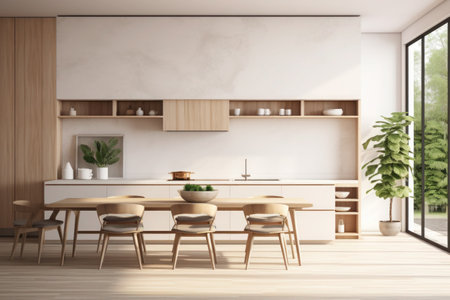Introduction to Open-Plan Kitchens in the UK
Open-plan kitchens have become a defining feature of contemporary British homes, transforming not only the way we cook but also how we interact within our living spaces. Traditionally, UK homes were characterised by distinct rooms, often with a dedicated kitchen tucked away at the back of the house. This design reflected both Victorian sensibilities and the practical need to contain cooking odours and heat. However, as lifestyles have evolved and the boundaries between cooking, dining, and living have blurred, so too has our approach to kitchen design. The open-plan concept now sits at the heart of many British renovations, offering an inviting space that encourages socialising, multitasking, and seamless movement. This growing trend is influenced by shifting cultural values—where entertaining guests, spending quality family time, and flexible working arrangements are increasingly prioritised. As a result, open-plan kitchens are no longer reserved for new builds or luxury properties; they have become an attainable aspiration across diverse housing types throughout the UK.
Benefits of an Open-Plan Kitchen
Open-plan kitchens have become a defining feature in contemporary British homes, offering a wealth of advantages that cater to the evolving lifestyles of UK homeowners. The shift away from compartmentalised living spaces towards open, fluid environments has elevated both the functionality and aesthetic appeal of domestic interiors.
Enhanced Social Interaction
One of the standout benefits is the promotion of social interaction. An open-plan kitchen blurs traditional boundaries between cooking, dining, and lounging areas, creating a communal hub where families and friends can connect seamlessly. Whether its hosting a Sunday roast, helping children with homework while preparing dinner, or enjoying a casual cup of tea with guests, the open layout encourages togetherness and communication—a true reflection of British hospitality.
Maximised Natural Light
British homes often contend with limited sunlight due to climate and architectural styles. Open-plan designs address this by removing internal walls and embracing larger windows or bi-fold doors. This allows natural light to flow more freely throughout the space, making interiors feel brighter and more inviting. The result is not only an uplifting atmosphere but also potential energy savings as reliance on artificial lighting decreases during daylight hours.
Versatile Living Spaces
The versatility offered by an open-plan kitchen cannot be overstated. Homeowners enjoy greater flexibility in how they use their living space, adapting it for different functions such as entertaining, working from home, or relaxing. This adaptability is especially valuable in urban UK properties where space is at a premium.
Key Advantages at a Glance
| Advantage | Description | Appeal to UK Homeowners |
|---|---|---|
| Enhanced Social Interaction | Facilitates easy conversation and shared activities across zones | Ideal for family gatherings and entertaining guests |
| Maximised Natural Light | Removes barriers to let sunlight permeate the whole space | Makes homes feel brighter despite typical British weather |
| Versatile Living Spaces | Allows flexible use for dining, working, or relaxing | Makes the most of limited square footage in UK homes |
A Lifestyle Upgrade Rooted in British Design Sensibilities
The open-plan kitchen trend resonates with those seeking a harmonious blend of style and practicality. It offers a modern solution that aligns with both British traditions of sociability and the need for efficient use of space—making it a highly attractive choice for todays homeowners.

3. Challenges and Considerations
While open-plan kitchens have become a defining feature in many British homes, they are not without their challenges. One of the most frequently cited drawbacks is noise control. With fewer walls to buffer sound, the hustle and bustle of kitchen activity—clattering pans, boiling kettles, and whirring appliances—can easily spill into living and dining areas. This can be particularly disruptive during family gatherings or when trying to relax in the lounge.
Another common concern is the management of cooking odours. Traditional British homes often featured separate kitchens with doors that could be closed to contain smells from frying fish or roasting Sunday dinners. In contrast, open-plan layouts allow aromas to drift freely throughout the home. Without effective ventilation systems or extractor fans, lingering food scents may become a daily nuisance.
Storage also poses a unique challenge in open-plan settings. British homes are known for their clever use of space, but removing walls often means sacrificing traditional cabinetry and larder cupboards. Homeowners must get creative with integrated storage solutions such as kitchen islands with built-in shelves, pull-out pantry units, or bespoke cabinetry that blends seamlessly with living room furnishings.
Design Adaptations for UK Homes
To address these challenges, it’s essential to approach open-plan design thoughtfully. Incorporating soft furnishings like rugs and curtains can help absorb sound, while installing high-quality extractor hoods keeps air fresh and clean. Additionally, opting for multi-functional furniture and discreet storage helps maintain a tidy aesthetic—a nod to British sensibility for orderliness within compact spaces.
The Importance of Zoning
Zoning is another key consideration. Using different flooring materials or lighting schemes can subtly delineate kitchen, dining, and living zones without erecting physical barriers. This maintains an airy feel while offering each area its own distinct character and purpose.
Conclusion
Ultimately, while open-plan kitchens offer social and visual benefits that appeal to contemporary British lifestyles, careful planning is crucial to mitigate noise, odour, and storage issues. By understanding these considerations and employing clever design strategies tailored to UK homes, it’s possible to enjoy the best of both worlds: a stylish space that’s as functional as it is inviting.
Integrating Open-Plan Kitchens with Traditional British Architecture
One of the most exciting challenges for homeowners and designers in the UK is blending the contemporary appeal of open-plan kitchens with the classic charm of traditional British architecture. From Victorian terraces to Edwardian townhouses and charming country cottages, British homes are renowned for their period features and character-rich details. Here’s how you can successfully integrate an open-plan layout without sacrificing the unique personality of your home.
Honouring Period Features While Embracing Openness
The key to a harmonious design lies in celebrating what makes your home special. Retain original cornices, ceiling roses, fireplaces, or exposed beams wherever possible. These elements provide a beautiful contrast against modern kitchen fittings and help anchor the new layout in its historical context. For instance, a sleek island unit can be positioned beneath ornate plasterwork, highlighting both old and new.
Smart Material Choices: Local and Authentic
Using local materials not only supports sustainability but also reinforces a sense of place. Opt for British stone worktops, reclaimed timber floors, or handmade ceramic tiles from regional artisans. Below is a table of recommended materials that blend seamlessly with period properties:
| Feature | Recommended Material | Why It Works |
|---|---|---|
| Worktops | Cotswold limestone, Welsh slate | Durable, locally sourced, blends naturally with historic interiors |
| Flooring | Reclaimed oak, flagstone, encaustic tiles | Adds warmth and authenticity; matches existing floors |
| Splashbacks & Tiles | Bespoke ceramics from UK potteries | Unique craftsmanship; enhances individuality |
| Cabinetry | Painted wood in heritage colours (Farrow & Ball) | Nods to traditional palettes; timeless yet fresh |
Maximising Light While Maintaining Cosiness
Open-plan designs are prized for their light-filled spaces. However, British homes often value cosiness (“cosy” being a beloved UK term). Use glass partitions or Crittall-style doors to divide zones while letting daylight filter through. Consider soft pendant lighting and warm-toned bulbs to create inviting nooks within the larger space.
A Celebration of Characterful Homes
No matter how modern your kitchen becomes, infusing personal touches keeps it quintessentially British. Display vintage crockery collections on open shelving, retain original picture rails for artwork, or incorporate antique furniture as part of your kitchen-diner setup. Above all, let your home’s story shine alongside the functionality of open-plan living—a true marriage of past and present that defines British style.
5. Practical Design and Planning Tips
Zoning Your Open-Plan Kitchen
Successful open-plan kitchens in the UK hinge on thoughtful zoning to create harmonious, functional spaces. Use kitchen islands or breakfast bars as visual dividers between cooking, dining, and living areas. Consider subtle changes in flooring material or rug placement to distinguish zones without breaking up the flow. For added character, British homes often incorporate bespoke shelving or glazed partitions—these offer definition while preserving that coveted sense of openness.
Lighting for Ambience and Function
The UK’s varied weather and natural light mean that layered lighting is essential. Maximise daylight with large windows or bi-fold doors where possible. Complement this with a blend of ambient ceiling lights, task lighting above preparation areas, and statement pendants over the dining table or island. Opt for dimmer switches to tailor the atmosphere for everything from weekday breakfasts to evening entertaining, accommodating those long winter nights and bright summer evenings alike.
Selecting Durable Finishes for UK Lifestyles
Given Britain’s unpredictable climate and bustling family life, durable finishes are vital. Choose high-quality worktops like quartz or composite stone that withstand heavy use and resist stains from the inevitable cuppa spills. Painted cabinetry in classic hues—think navy, sage, or cream—offers timeless appeal while concealing everyday wear. For flooring, luxury vinyl tiles or engineered wood cope well with muddy boots, pets, and temperature changes common in UK homes.
Incorporating British Design Touches
Add local character with metro tiles, Cotswold-inspired colour palettes, or heritage brass hardware. These elements celebrate British design heritage and ensure your open-plan kitchen feels both contemporary and rooted in place.
Final Thought
A thoughtfully planned open-plan kitchen balances style with practicality, tailored to the rhythms of UK living—blending comfort, durability, and beauty for years to come.
6. Conclusion: Is an Open-Plan Kitchen Right for Your Home?
The open-plan kitchen has swiftly become a hallmark of modern British homes, celebrated for its ability to foster sociability, maximise light, and enhance the feeling of space. However, as with any design trend, it’s essential to weigh up both the pros and cons before making such a significant change. Throughout this article, weve explored how open-plan kitchens can create a seamless flow between cooking, dining, and living areas—perfect for family life and entertaining. Yet, weve also acknowledged challenges such as noise, odours, and potential loss of privacy.
Before embarking on your own open-plan transformation, UK homeowners should consider several key factors. Firstly, assess your household’s lifestyle: do you value communal spaces or do you require quiet zones for work or relaxation? Secondly, think about your property type; while many Victorian terraces or period homes can be beautifully reimagined with an open layout, structural considerations—like supporting walls—may impact feasibility and cost. Planning permission and building regulations are also crucial, so consulting local authorities is advisable.
In addition, consider how you’ll manage storage and maintain organisation in a more exposed setting. Thoughtful integration of cabinetry, zoning through clever use of furniture or flooring, and investment in good extraction systems can all help mitigate typical downsides. Ultimately, the decision comes down to balancing aesthetics with practicality while respecting the character of your home and the needs of your household. With careful planning and attention to detail, an open-plan kitchen can truly elevate your living experience in a way that feels both contemporary and quintessentially British.

